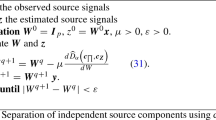Abstract
In this paper, we consider independence property between a random process and its first derivative. Then, for linear mixtures, we show that cross-correlations between mixtures and their derivatives provide a sufficient number of equations for analytically computing the unknown mixing matrix. In addition to its simplicity, the method is able to separate Gaussian sources, since it only requires second order statistics. For two mixtures of two sources, the analytical solution is given, and a few experiments show the efficiency of the method for the blind separation of two Gaussian sources.
Access this chapter
Tax calculation will be finalised at checkout
Purchases are for personal use only
Preview
Unable to display preview. Download preview PDF.
Similar content being viewed by others
References
Jutten, C., Hérault, J.: Blind Separation of Sources, Part I: an Adaptive Algorithm Based on a Neuromimetic Architecture. Signal Processing 24, 1–10 (1991)
Cardoso, J.-F., Souloumiac, A.: Blind beamforming for non Gaussian signals. IEE Proceedings-F 140, 362–370 (1993)
Bell, T., Sejnowski, T.: An Information-Maximization Approach to Blind Separation and Blind Deconvolution. Neural Comutation 7, 1004–1034 (1995)
Yellin, D., Weinstein, E.: Criteria for multichannel signal separation. IEEE Trans. on Signal Processing 42, 2158–2168 (1994)
Nguyen Thi, H.L., Jutten, C.: Blind Sources Separation For Convolutive mixtures. Signal Processing 45, 209–229 (1995)
Babaie-Zadeh, M.: On blind source separation in convolutive and nonlinear mixtures. PhD thesis, INP Grenoble (2002)
Pajunen, P., Hyvärinen, A., Karhunen, J.: Non linear source separation by selforganizing maps. In: Proceedings of ICONIP 1996, Hong-Kong (1996)
Taleb, A., Jutten, C.: Source separation in post nonlinear mixtures. IEEE Transactions on Signal Processing 47, 2807–2820 (1999)
Comon, P.: Independent Component Analysis, a new concept? Signal Processing 36, 287–314 (1994)
Tong, L., Soon, V., Liu, R., Huang, Y.: AMUSE: a new blind identification algorithm. In: Proceedings ISCAS, New Orleans, USA (1990)
Belouchrani, A., Abed Meraim, K., Cardoso, J.-F., Moulines, E.: A blind source separation technique based on second order statistics. IEEE Trans. on Signal Processing 45, 434–444 (1997)
Molgedey, L., Schuster, H.G.: Separation of a mixture of independent signals using time delayed correlation. Physical Review Letters 72, 3634–3636 (1994)
Matsuoka, K., Ohya, M., Kawamoto, M.: A neural net for blind separation of nonstationary signals. Neural Networks 8, 411–419 (1995)
Pham, D.T., Cardoso, J.-F.: Blind Separation of Instantaneous Mixtures of Non Stationary Sources. IEEE Transaction on Signal Processing 49, 1837–1848 (2001)
Adams, W.W., Loustaunau, P.: An Introduction to Gröbner Bases. Amer. Math. Soc., Providence (1994)
Papoulis, A.: Probability, Random Variables, and Stochastic Processes, 3rd edn. International Editions. Electronical and Electronic Engineering Series. McGraw-Hill, New York
Author information
Authors and Affiliations
Editor information
Editors and Affiliations
Rights and permissions
Copyright information
© 2004 Springer-Verlag Berlin Heidelberg
About this paper
Cite this paper
Lagrange, S., Jaulin, L., Vigneron, V., Jutten, C. (2004). Analytical Solution of the Blind Source Separation Problem Using Derivatives. In: Puntonet, C.G., Prieto, A. (eds) Independent Component Analysis and Blind Signal Separation. ICA 2004. Lecture Notes in Computer Science, vol 3195. Springer, Berlin, Heidelberg. https://doi.org/10.1007/978-3-540-30110-3_11
Download citation
DOI: https://doi.org/10.1007/978-3-540-30110-3_11
Published:
Publisher Name: Springer, Berlin, Heidelberg
Print ISBN: 978-3-540-23056-4
Online ISBN: 978-3-540-30110-3
eBook Packages: Springer Book Archive




